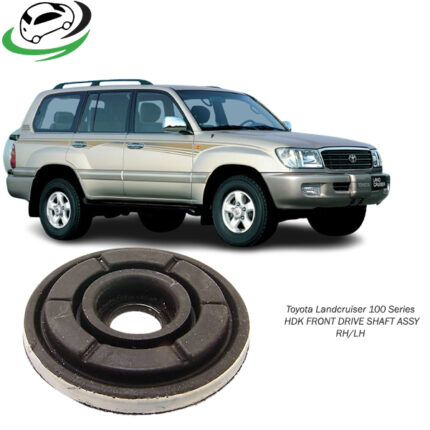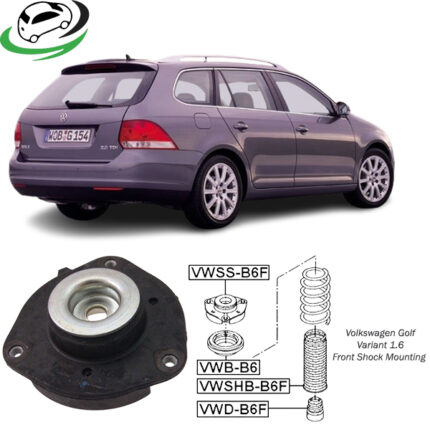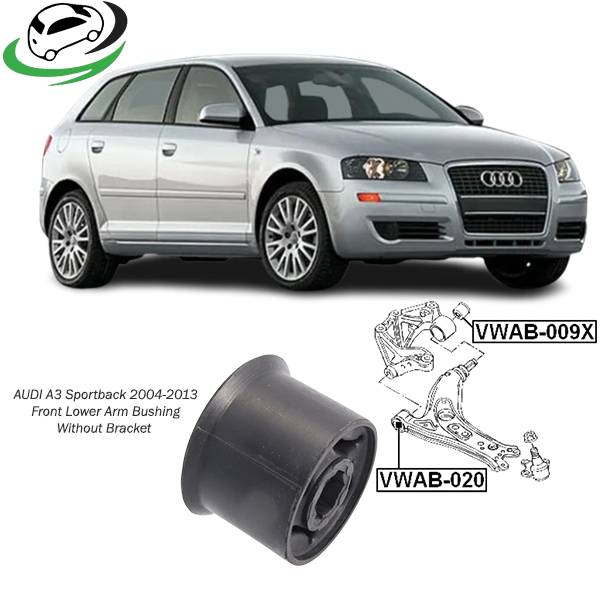-10%
Get AUDI A3 Sportback 2004-2013 Front Lower Arm Bushing Without Bracket VWAB-009X In Kenya
Arm bushings are critical components in a vehicle’s suspension system. They are typically found at the pivot points of control arms, trailing arms, and other suspension links. These bushings play a vital role in maintaining proper alignment, absorbing shocks, and reducing vibrations, thus contributing significantly to ride comfort and vehicle stability.
Function of Arm Bushings
1. Vibration Damping
Arm bushings isolate the vehicle’s chassis from the suspension components, reducing the transmission of vibrations and road noise to the passenger cabin. This results in a smoother and quieter ride.
2. Alignment Maintenance
Bushings maintain the alignment of suspension components. Proper alignment ensures that wheels are correctly positioned, which is crucial for effective steering, handling, and tire wear.
3. Shock Absorption
Arm bushings absorb shocks and impacts from the road surface, protecting suspension components and the chassis from excessive stress and potential damage. This also enhances ride comfort by cushioning the impacts felt by passengers.
4. Flexibility and Movement
Bushings allow a controlled amount of movement in the suspension arms, which is necessary for accommodating changes in road conditions and driving dynamics. This flexibility ensures that the suspension can respond effectively to various driving situations.
5. Load Distribution
By distributing the loads and stresses experienced by the suspension arms, bushings help prevent concentrated wear and tear on specific components, enhancing the overall durability and reliability of the suspension system.
Types of Arm Bushings
1. Rubber Bushings
- Characteristics: Made from natural or synthetic rubber, these bushings offer excellent vibration damping and flexibility.
- Advantages: Cost-effective, good vibration isolation.
- Disadvantages: Can wear out relatively quickly, especially under harsh driving conditions.
2. Polyurethane Bushings
- Characteristics: More durable than rubber, polyurethane bushings offer enhanced performance and longevity.
- Advantages: Better resistance to wear, chemicals, and aging.
- Disadvantages: Can be harsher, transmitting more noise and vibration compared to rubber bushings.
3. Solid Bushings
- Characteristics: Made from materials like metal or hard plastic, these bushings are used in high-performance applications.
- Advantages: Provide maximum rigidity and alignment precision.
- Disadvantages: Offer the least vibration damping, significantly increasing noise and harshness.
4. Hydraulic Bushings
- Characteristics: Incorporate a hydraulic fluid chamber to provide superior damping characteristics.
- Advantages: Excellent vibration isolation and ride comfort.
- Disadvantages: More complex and expensive than other types of bushings.
Signs of Worn-Out Arm Bushings
1. Unusual Noises
- Clunking or Thumping: Noises during acceleration, braking, or going over bumps can indicate worn bushings.
- Squeaking or Creaking: These sounds can occur when bushings lose their flexibility and lubrication.
2. Poor Handling and Stability
- Wandering or Loose Steering: A loose or unstable feel in the steering can be a sign of bushing wear.
- Increased Body Roll: Worn bushings can lead to excessive body roll during cornering.
3. Vibration and Harshness
- Increased Vibrations: More vibrations felt in the cabin can indicate that the bushings are no longer effectively isolating the chassis from the suspension.
- Harsher Ride: A rougher ride quality can be due to the reduced cushioning effect of worn bushings.
4. Uneven Tire Wear
- Irregular Tire Wear: Misalignment caused by worn bushings can lead to uneven tire wear patterns, reducing tire life.
5. Visual Inspection
- Visible Damage: Cracks, tears, or deformation of the bushing material can be seen upon inspection.
Maintenance and Replacement
1. Regular Inspection
- Routine Checks: Regularly inspect bushings for signs of wear and damage as part of routine vehicle maintenance.
Signs Of Worn Out Arm Bushes;
1. Unusual Noises
Clunking or Thumping Sounds
- Symptoms: When accelerating, braking, or going over bumps, you might hear clunking or thumping noises coming from the suspension area.
- Cause: These sounds are typically due to excessive play in the suspension components as a result of deteriorated bushings.
Squeaking or Creaking Sounds
- Symptoms: Squeaking or creaking noises, especially during cornering or when driving over uneven surfaces.
- Cause: Worn bushings can lose their lubrication and flexibility, causing metal components to rub against each other.
2. Poor Handling and Stability
Wandering or Loose Steering
- Symptoms: The vehicle may feel less stable and tend to wander or have a loose steering feel, particularly at higher speeds.
- Cause: Worn bushings can affect the alignment of suspension components, leading to imprecise steering and reduced control.
Increased Body Roll
- Symptoms: More noticeable body roll or sway when cornering or making sharp turns.
- Cause: Worn bushings can no longer maintain proper alignment and support of the suspension arms, leading to excessive movement.
3. Vibration and Harshness
Increased Vibrations
- Symptoms: Greater vibrations felt in the cabin, particularly at higher speeds or during acceleration.
- Cause: Worn bushings fail to effectively isolate the chassis from the suspension, allowing vibrations to transfer to the vehicle body.
Harsher Ride
- Symptoms: A rougher, less comfortable ride, with more road imperfections and shocks being felt.
- Cause: The reduced cushioning effect of deteriorated bushings results in a less smooth ride experience.
4. Uneven Tire Wear
Irregular Tire Wear
- Symptoms: Uneven or abnormal tire wear patterns, often more pronounced on one side.
- Cause: Misalignment caused by worn bushings can lead to improper contact between the tires and the road, accelerating tire wear.
5. Visual Inspection
Visible Damage
- Symptoms: Cracks, tears, or other visible signs of wear and deterioration on the bushing material.
- Cause: Regular exposure to stress, temperature changes, and environmental factors can cause the material to degrade over time.
Compression or Misshapen Bushings
- Symptoms: Bushings appear compressed, misshapen, or otherwise deformed.
- Cause: Continuous pressure and stress can cause the bushing material to lose its original shape and effectiveness.
6. Leaking Hydraulic Fluid (For Hydraulic Bushings)
Fluid Leaks
- Symptoms: Wet spots or puddles of hydraulic fluid under the vehicle.
- Cause: Damaged hydraulic bushings can leak fluid, indicating that the bushing’s damping capabilities are compromised.
2. Replacement Process
- Vehicle Preparation: Lift and support the vehicle securely.
- Remove Suspension Arm: Depending on the vehicle, this may involve disconnecting various components.
- Remove Old Bushing: Special tools are often required to press out the old bushing.
- Install New Bushing: Press the new bushing into place, ensuring proper alignment.
- Reassemble Suspension Arm: Reattach all components and torque to manufacturer specifications.
Follow us on Facebook for more parts.



